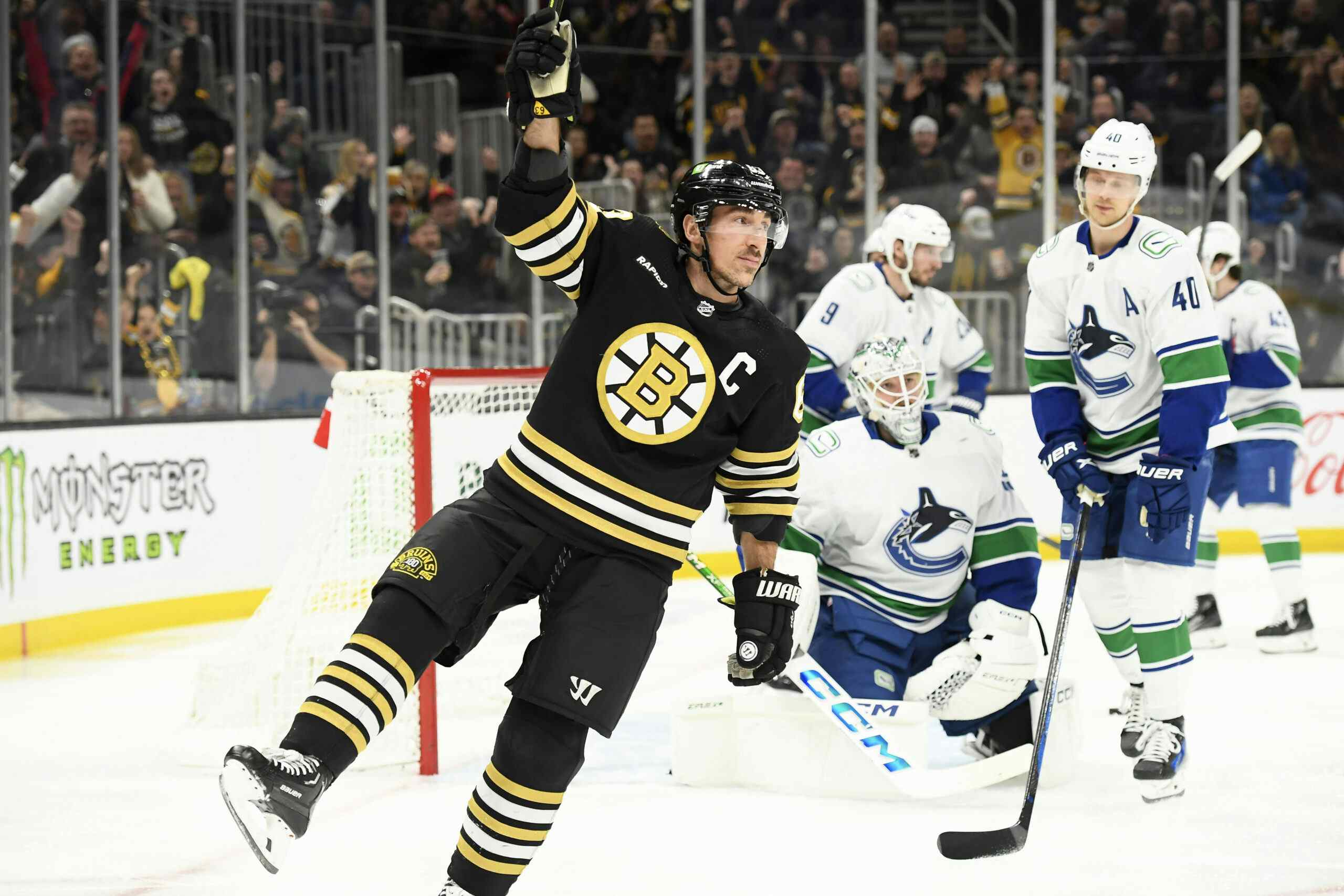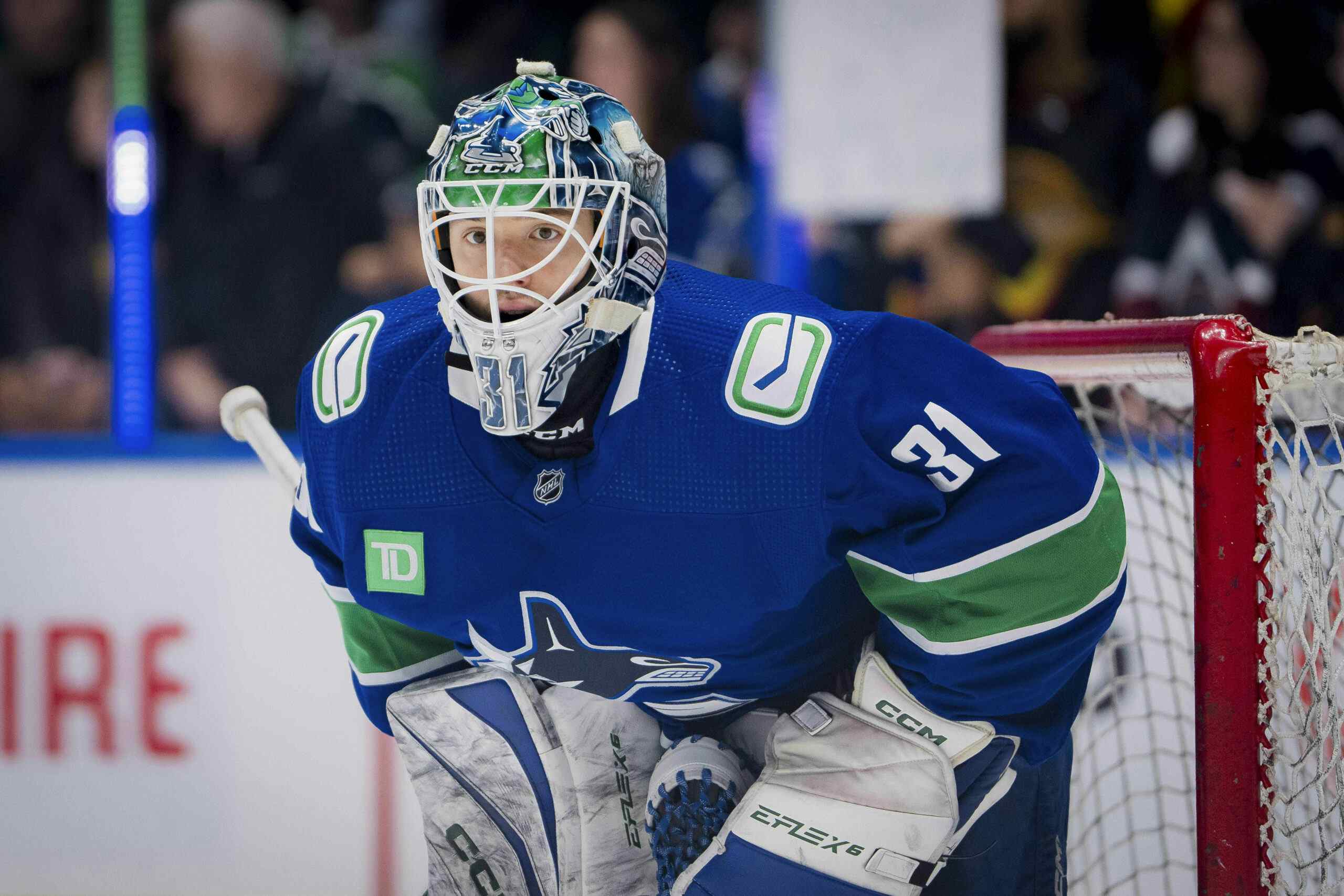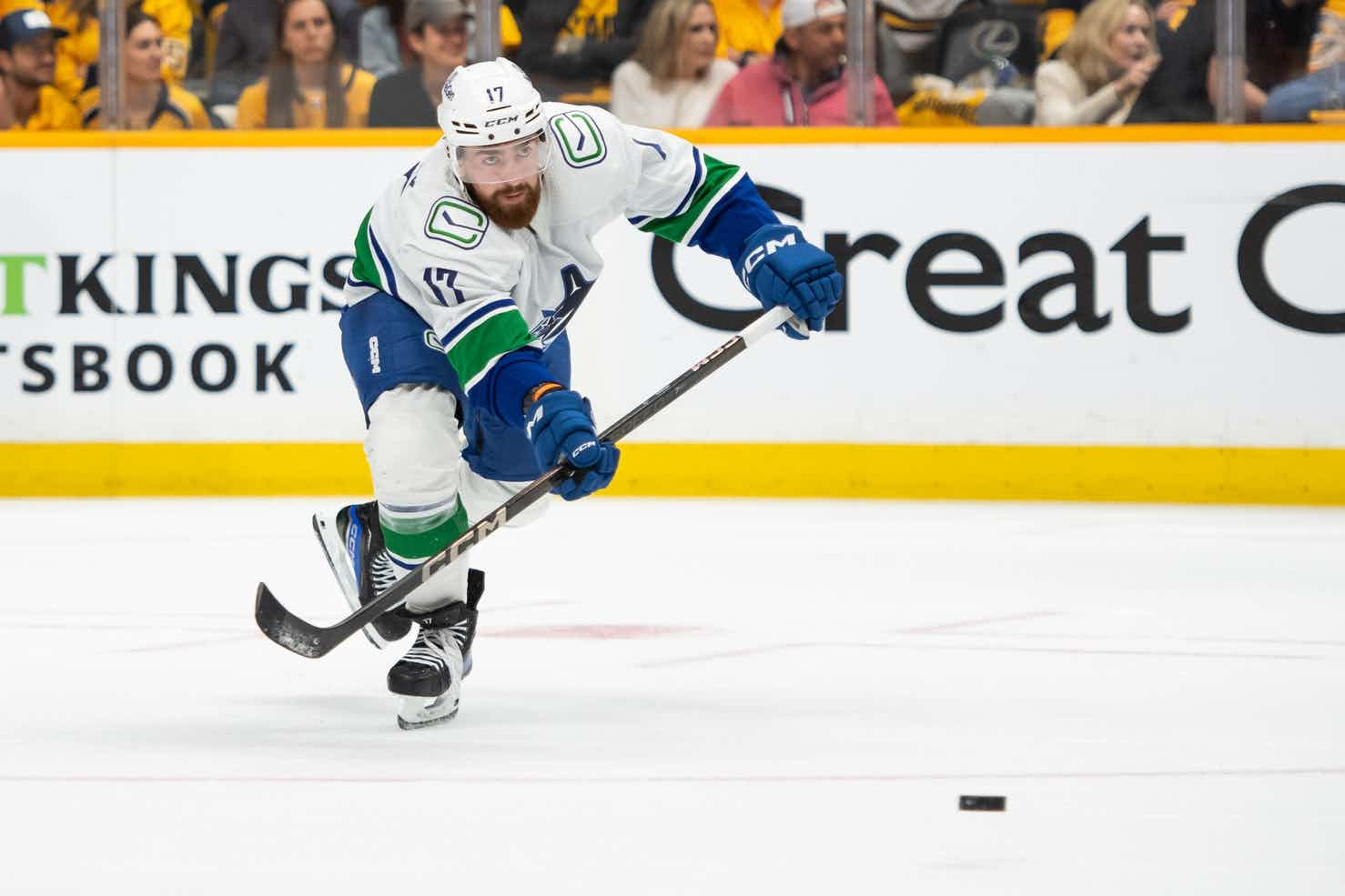For Better or For Worse: Did the Canucks’ defence improve this offseason?

The 2020 offseason was one of great change for the Vancouver Canucks. But was it a caterpillar-to-butterfly sort of transformation, or a metamorphosis of the Kafkaesque variety?
In our For Better or For Worse series, we’re holding the 2021 Canucks up against the standard set by the 2019/20 roster to answer the offseason’s burningest question: did the Canucks get better, or did they get worse?
Today, it’s time to examine the restructured blueline, spot-for-spot.
#1 LD: Sophomore Quinn Hughes vs Rookie Quinn Hughes
| Quinn Hughes | Games | Goals | Assists | Points | Avg. TOI | Corsi For |
| 2019/20 | 68 | 8 | 45 | 53 | 21:53 | 53% |
| Career | 73 | 8 | 48 | 56 | 21:37 | 53.1% |
The Canucks’ number one defender in 2021 is going to be the same person it was by the end of 2019/20. Theoretically speaking, a Hughes that is one year older, one year wiser, and with one full year of pro experience under his belt should be an improvement on the rookie Hughes of last year.
There are some reasons to believe that Hughes’ production will drop a little from the 63-point pace he scored at last season. Opposing teams will now key in on him more than before, he’ll be competing for minutes with Nate Schmidt, and there’s always that dreaded sophomore slump.
Really, though, even if Hughes produces less — and there’s just as good a chance he actually produces more — his overall game is almost certain to get better, as it did continuously throughout the 2019/20 season.
Therefore, in the most important spot on the blueline, the Canucks should be at least a little bit better off.
#1 RD: Nate Schmidt vs Chris Tanev
| Nate Schmidt | Games | Goals | Assists | Points | Avg. TOI | Corsi For |
| 2019/20 | 59 | 7 | 24 | 31 | 21:41 | 52.9% |
| Career | 396 | 29 | 111 | 140 | 19:15 | 51.4% |
| Chris Tanev | Games | Goals | Assists | Points | Corsi For | |
| 2019/20 | 69 | 2 | 18 | 20 | 19:32 | 46.2% |
| Career | 514 | 22 | 96 | 118 | 19:44 | 49.2% |
It’s debatable as to who truly was the Canucks’ top defender on the right side in 2019/20. On the basis of ice-time, it would seem to be Tyler Myers, but in terms of overall responsibility, it was probably Chris Tanev.
Either way, there’s not much debate to be had about Schmidt being a significant upgrade on either.
In 2019/20, Schmidt’s statline blew Tanev and Myers out of the water, a feat that’s all the more impressive given the context of Schmidt’s deployment. Only two other defensemen in the entire league played against tougher competition than Schmidt, and one of them was his regular partner.
Though his spot at the top of the Vegas depth chart was somewhat usurped by Shea Theodore last year — and though he has next to no chance of ever outranking Hughes — Schmidt still has all the qualities of a number one defender. That’s something that the Canucks haven’t ever really had on their right side.
Thus, it’s perfectly clear that the top two spots on the Canucks’ blueline, even if Hughes and Schmidt don’t actually end up paired together, has been significantly upgraded.
#2 LD and RD: The Same Ol’ Alex Edler and Tyler Myers
| Alex Edler | Games | Goals | Assists | Points | Avg. TOI | Corsi For |
| 2019/20 | 59 | 5 | 28 | 33 | 22:37 | 49.0% |
| Career | 873 | 99 | 302 | 401 | 23:02 | 50.3% |
| Tyler Myers | Games | Goals | Assists | Points | Avg. TOI | Corsi For |
| 2019/20 | 68 | 6 | 15 | 21 | 21:30 | 48.6% |
| Career | 703 | 80 | 206 | 286 | 22:17 | 48.2% |
The remainder of the Canucks’ top-four will be made up by two players who there last year in Edler and Myers. For the most part, they’re both known quantities, but there’s still some wiggle room in their potential 2021 performance worth discussing.
Myers had a bit of a down year in terms of production, which makes sense after switching teams the previous offseason. His defensive game also fluctuated, with some major highs (the shutting down of Alex Tuch in the playoffs) mitigated by some devastating lows (all those gaffes and penalties).
With Schmidt on the right side, expect Myers’ minutes to go down, which may end up benefitting his overall play, but also cuts into the chances of his production rebounding.
Edler, on the other hand, is called “Steady Eddie” for a reason. Edler’s production, ice-time, and possession metrics have been consistent throughout his 30s, and though some rust is starting to show on his defensive game — especially on the penalty kill — he’s not yet so old that the wheels are going to come fully off anytime soon.
Expect more-or-less the same Edler in 2021 that we got in 2019/20.
And with another year’s worth of ageing on Edler balancing out the slim chance at a slightly better performance from Myers, we’ll have to call the lower half of the top-four a push. It’s not any better than it was last season, but it’s also not any worse.
#3 LD: Olli Juolevi/Jordie Benn/Jack Rathbone vs Oscar Fantenberg
| Olli Juolevi | Games | Goals | Assists | Points | Avg. TOI | Corsi For |
| 2019/20 (AHL) | 45 | 2 | 23 | 25 | N/A | N/A |
| Career (AHL) | 63 | 3 | 35 | 38 | N/A | N/A |
| Jack Rathbone | Games | Goals | Assists | Points | Avg. Toi | Corsi For |
| 2019/20 (NCAA) | 28 | 7 | 24 | 31 | N/A | N/A |
| Career (NCAA) | 61 | 14 | 39 | 53 | N/A | N/A |
| Oscar Fantenberg | Games | Goals | Assists | Points | Avg. TOI | Corsi For |
| 2019/20 | 36 | 1 | 5 | 6 | 15:55 | 43.5% |
| Career | 124 | 5 | 14 | 19 | 15:36 | 47.4% |
With Juolevi and Rathbone, two rookies who will be vying to replace Fantenberg’s left-side minutes on the bottom pairing, there’s no real way of knowing how well they’ll perform at the NHL level. Heck, Rathbone has still yet to play a professional hockey game.
But given the quality of Fantenberg’s play last year — especially in the postseason, where he was in the running for the dubious distinction of statistically worst playoff defender — it’s tough to imagine them doing any worse. That’s especially true given that one of them will have to beat out the other for the spot.
Juolevi brings calm, poise, and vision to the table. Rathbone, one of the most talented players in the entire NCAA last season, already offers more skill than Fantenberg.
If neither of the two steps up in training camp, however, the job will fall to Benn by default. As it stands, that’s a downgrade, because Benn straight-up lost his place in the lineup to Fantenberg last season. With that being said, Benn also seems like one of the players on the roster most primed to enjoy a rebound, and he wouldn’t need to rebound that much to improve on Fantenberg’s standard.
Ultimately, this particular position is a little too nebulous to make any definitive declarations quite yet, but suffice it to say that the Canucks should not be too worried about a dip in quality.
#3 RD: Brogan Rafferty/Jordie Benn vs Troy Stecher
| Brogan Rafferty | Games | Goals | Assists | Points | Avg. TOI | Corsi For |
| 2019/20/Career | 57 | 7 | 38 | 45 | N/A | N/A |
| Jordie Benn | Games | Goals | Assists | Points | Avg. TOI | Corsi For |
| 2019/20 | 44 | 1 | 6 | 7 | 16:17 | 43.3% |
| Career | 517 | 23 | 94 | 117 | 17:54 | 50.5% |
| Troy Stecher | Games | Goals | Assists | Points | Avg. TOI | Corsi For |
| 2019/20 | 69 | 5 | 12 | 17 | 15:21 | 48.7% |
| Career | 286 | 11 | 64 | 75 | 18:34 | 49.3% |
Like any good dramatist, we’ve saved the cruel twist for the very end.
The 25-year-old Rafferty had a dynamite rookie pro season in 2019/20, making the AHL All-Rookie Team and finishing fourth in Utica Comets scoring. Most who viewed him regularly assume he’ll be able to transition into the big leagues with minimal issues, and should have no problem assuming a mildly-sheltered bottom-pairing role with ample offensive opportunities.
Living up to the standard set by Stecher, however, is another matter entirely.
Consistently underrated and unheralded, Stecher performed better statistically than any other right-side defender in Vancouver last season, despite limited minutes. Every other defender played better when paired with Stecher, and he put up the most impressive playoff performance by any defenceman not named Hughes.
Having Rafferty come in and perform as well as Stecher did in his own rookie campaign would have to be considered a success. Having Rafferty come in and perform as well as Stecher did last year? That’s just not a realistic expectation, no matter how big of a Brogan booster you are.
If Rafferty falters in training camp, Benn will likely slide over to the right and take the spot. Those who follow the Montreal Canadiens will attest that that’s where Benn plays his best hockey, but there wasn’t much evidence of that in Vancouver last season. Again, Benn is primed for a bounceback, and the right side is probably the place to do it. Again, actually replacing what Stecher brought on a nightly basis seems like a bridge too far.
Here, the Canucks have undoubtedly taken a step back.
Final Verdict:
The Canucks will see at least two, and probably three, new faces on their blueline that weren’t there when they opened 2019/20.
Nate Schmidt is a massive improvement on Chris Tanev, as much as we all loved the guy.
Oscar Fantenberg is highly replaceable, and the Canucks have a couple of intriguing options there.
The loss of Troy Stecher, however, will not be easy to compensate for, no matter how well Brogan Rafferty transitions into the NHL.
The real question, then, is whether the upgrade of Schmidt makes up for the downgrade on Stecher. And the answer is unequivocally in the affirmative.
Schmidt is a top-pairing defender ready and willing to eat up 22 minutes each and every game. Last season, Stecher averaged just 15:21.
The addition of Schmidt, combined with another year of Quinn Hughes’ development, instantly gives the Canucks one of the best top-fours in the Western Conference, or the Canadian Division, or wherever they end up playing in 2021.
A couple of question marks on the bottom pairing is, comparatively, an easy problem to fix, and one with fewer consequences in the interim.
So, yes, Vancouver’s defence got better this offseason. It’s been a while since we could say that, and it sure feels good.
Recent articles from Stephan Roget





